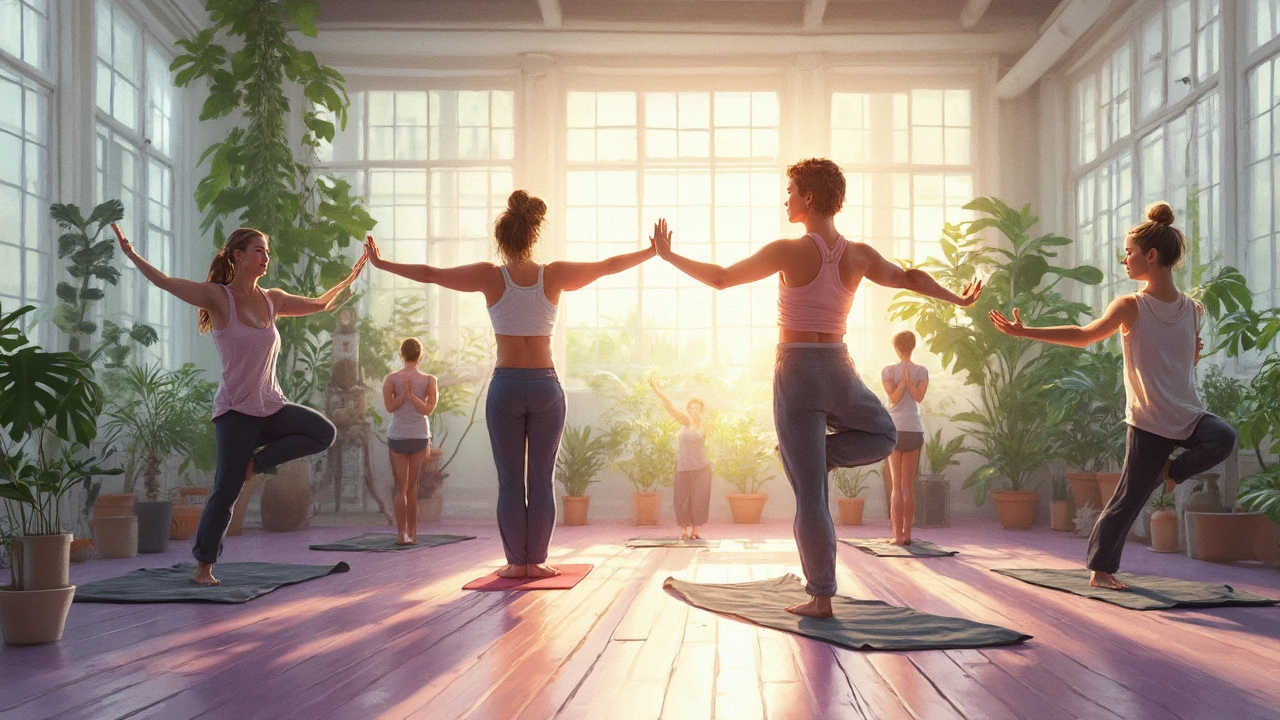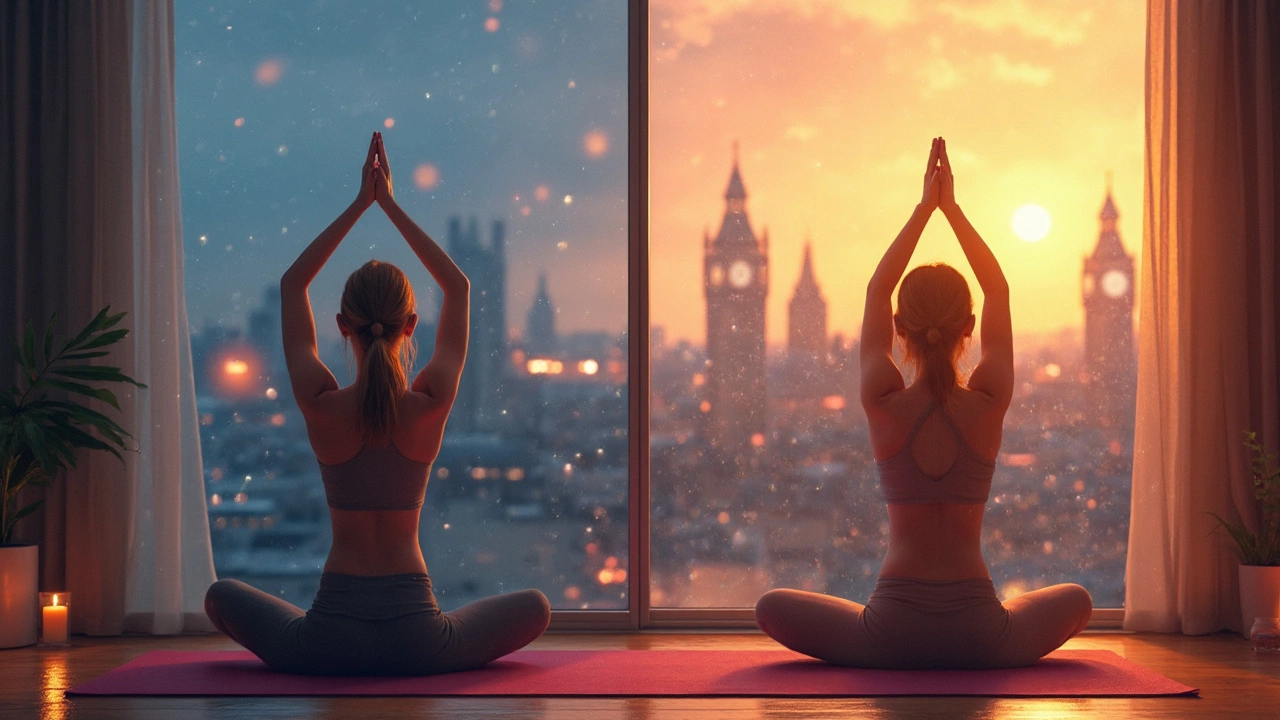How Much Yoga Should Beginners Practice?
 Mar, 9 2025
Mar, 9 2025
Have you just rolled out your yoga mat for the first time and wondered how often you should be practicing? You're not alone! For newcomers to yoga, finding the sweet spot between practicing too much and not enough can be tricky. But don't worry, we're here to unravel this mystery.
In the whirlwind of newly discovered postures and breathing exercises, savvy beginners often ask about the right frequency for practice. Many yoga teachers suggest that starting with two to three times a week is a great way to build a foundation without feeling overwhelmed. It gives your body time to learn new positions while allowing you time to recover.
The duration of each session is another vital point - sticking to 20-30 minutes per session is totally sufficient when you're just starting out. It's enough time to warm up, practice a few poses, and cool down. Think of it as building a daily habit without being daunting or too time-consuming.
- Why Start Yoga?
- Ideal Frequency for Beginners
- Duration of Sessions
- Choosing the Right Yoga Style
- Tips for Effective Practice
- Monitoring Your Progress
Why Start Yoga?
Diving into yoga for beginners might just be the best thing you do for your mind and body. Ever wondered about those serene smiles on yogis? Yoga goes beyond just physical exercise; it combines the mind, body, and spirit in a way that's hard to find in other exercises.
Stress Relief and Mental Health
In today's fast-paced world, stress is a constant companion for many of us. Practicing yoga can significantly help reduce stress. How? Through those mindful breathing exercises and meditation that come as a package deal. A study even found that people who practice yoga report lower levels of anxiety and better moods. So why not give it a shot?
Flexibility and Strength
Now, you're probably thinking, "I can't even touch my toes!" Guess what? Most of us start there. One of the sweet benefits reported by new yogis is improved flexibility. You'll notice changes faster than you think. And as a bonus, you build strength in ways that surprise many beginners. It's like unlocking a superpower you didn't know you had.
Personal Growth and Focus
Let's not forget the mental clarity part. Yoga encourages personal growth. It helps you connect with yourself, enhancing your ability to focus and be present. This can trickle into other parts of your life, like decision-making and improving work performance.
| Benefits | Description |
|---|---|
| Stress Relief | Meditation and breathing reduce anxiety |
| Flexibility | Improves joint and muscle range |
| Mental Clarity | Enhances concentration |
So, whether you're looking to destress or build body strength, yoga's got you covered. Besides, you don't need fancy equipment or a gym membership—just some space and maybe a good mat. Are you ready to see what yoga can do for you?
Ideal Frequency for Beginners
When you first dip your toes into the world of yoga for beginners, one of the first questions is often: how often should I practice? It's a good one because finding the right balance is crucial. You want to practice enough to learn and see benefits but not so much that you feel overwhelmed.
For most newbies, starting with 2-3 sessions per week hits the sweet spot. Practicing beginner yoga two to three times allows your body to adapt and gives you rest days that help prevent burnout. Rest is just as important as practice because it’s when the body heals and grows.
Slow and Steady Wins the Race
Many people think more is better, but when you’re starting out, it’s not just about logging hours on the mat. It’s about mindful practice. Being consistent with your sessions, even if they are short and simple, is more effective than cramming all at once.
Listen to Your Body
Remember that everybody is different. Some people might find they enjoy yoga more frequently, while others need more breaks. Pay attention to how your body responds and adjust your routine. If you feel any strain or discomfort, it's okay to pull back a bit.
It's also interesting to note that according to a study by Yoga Alliance, people who practice yoga even once a week tend to report improvements in their mental health and stress levels. This reflects how impactful even a small number of sessions can be, especially for those new to the practice.
Making It a Habit
The key is building a habit into your routine. Try to practice at the same time on your chosen days. This helps it fit into your lifestyle seamlessly and before you know it, starting yoga will be a natural part of your week. So go ahead, pick those two or three days, and get on the mat!
Duration of Sessions
So, how long should you really practice yoga if you're just getting started? The magic number for beginners typically hovers around 20 to 30 minutes per session. This duration is perfect to dive into the basics without feeling like you've gone five rounds with a heavyweight.
At first, sticking to shorter sessions helps keep things manageable. After all, you’re learning new poses and concepts. Overloading yourself isn't the goal here. Instead, it's about slowly letting your body and mind adjust to the rhythms of yoga. There's plenty of time to extend sessions once you're more comfortable.
Why 20-30 Minutes Works
This timeframe allows you to accomplish a full session that includes warming up, practicing various yoga poses, and cooling down. Here’s how you might break that down:
- Warm-up (5-10 minutes): Preps your body for what’s coming, maybe some gentle stretches or breathing exercises.
- Main Practice (10-15 minutes): This is where you focus on performing poses, maybe trying out the yoga for beginners sequences.
- Cool Down (5 minutes): End your practice with relaxation, letting your body and mind process the session.
Consistency is key over duration when you're starting. By regularly committing to these shorter sessions, you form a solid habit that exposes you to different types of moves and breathing exercises without the commitment panic.
Another thing to keep in mind is listening to your body. If a 20-minute session feels just right one day but a bit tough on another, it’s totally okay to adjust. The goal is to form a sustainable routine, so flexibility in your approach is important.
Longer sessions aren’t necessarily better. Practicing smaller doses regularly can naturally lead to longer and more intuitive practices as you grow comfortable. That said, be gentle with yourself – it’s all part of the journey!

Choosing the Right Yoga Style
Starting out in the world of yoga can be a bit like stepping into a candy store. There are so many varieties to choose from! If you're a beginner, picking the right style might feel overwhelming, but a little guidance can simplify things.
For those just getting started, Hatha Yoga is often recommended. It's a great entry point because it focuses on basic postures and breathing techniques at a slower pace, perfect for understanding the foundation of yoga. It's a non-intimidating introduction to the yoga for beginners journey.
Another popular choice is Vinyasa Yoga, which is more dynamic and suits those who enjoy movement. It flows quicker, linking poses together in a series. For beginners who are a bit more athletic and enjoy a good workout, this could be exciting.
Trying Something Different
Looking for something relaxing? Restorative Yoga might be your cup of tea. It emphasizes relaxation and stress relief, allowing you to melt into each pose, often supported by props. If you're someone who has a hectic lifestyle and seeks to unwind, this might be the style for you.
If you want to mix fitness with peace of mind, try Power Yoga. It can be challenging but also rewarding if you're up for the sweat. Though not typically recommended for absolute beginners, those with some background in fitness might adapt comfortably.
- Hatha Yoga: Great for mastering the basics.
- Vinyasa Yoga: Perfect if you enjoy more movement.
- Restorative Yoga: Focus on relaxation and stress relief.
- Power Yoga: Ideal for a fitness challenge mixed with relaxation.
Trying out different classes might also help you decide. Most yoga studios offer a mix of styles, so feel free to explore before committing fully. By understanding the key characteristics of each style, you can choose the best beginner yoga fit for your goals and lifestyle.
Tips for Effective Practice
Alright, you've decided to hop on the yoga for beginners train and you're ready to make it count. Here are some solid tips to make sure you get the most out of each session without turning it into a drag.
Listen to Your Body
Your body is your best teacher. If something feels off or uncomfortable, skip that pose or modify it. Yoga isn't about pushing through pain but finding a balance. Over time, your flexibility and strength will increase naturally.
Set Realistic Goals
Let's be real—you're not going to master the one-handed tree pose on day one. Start simple and set achievable goals like improving posture or reduced stress levels. Tracking small milestones can keep you motivated on your beginner yoga journey.
Create a Consistent Schedule
Setting a routine is key. Aim to practice at the same time every week. This helps reinforce your new habit and trains your brain to look forward to it as a wellness break instead of a chore.
Invest in a Good Mat
A quality yoga mat is worth the spend. You'll want something non-slip and cushioned to support you through those stretches. It makes starting yoga a more comfortable experience.
Stay Hydrated
The importance of hydration can't be overstated. Drink water before and after your practice to keep your muscles supple and prevent cramps.
Leverage Online Resources
With a plethora of online classes, ranging from live sessions to pre-recorded videos, you can find plenty of beginner-friendly content. Don't hesitate to pause and replay difficult sections to get the hang of it.
Monitor Progress with a Journal
Keep a yoga journal where you jot down what you've learned and how you feel after each session. Over time, you'll see trends, improvements, and areas that need focus. Seeing progress on paper can be super motivating.
Monitoring Your Progress
Keeping track of your beginner yoga journey is a fantastic way to stay motivated and see how far you've come. But how do you know you're on the right track? Let’s break it down.
Record Your Sessions
Jotting down notes after each practice is like writing a little journal for your yoga journey. Note the time you spent, the poses you struggled with, and any personal goals you're aiming to achieve. This method not only shows how you're improving over time but also highlights areas that may need extra attention.
Flexibility and Strength Check
One great way to monitor progress is to pick a few poses to revisit regularly. Notice any changes in your flexibility or strength when attempting these poses. Are you getting better at reaching your toes, or holding a plank longer? These little victories add up!
"Yoga is not about touching your toes, it is what you learn on the way down." - Jigar Gor
Listen to Your Body
Tune in to what your body is telling you. Feeling more energetic, relaxed, or sleeping better after practice? These are all signs of progress. Energy and sleep quality are often good indicators of how well your new yoga schedule is working for you.
Engage with Online Communities
Join forums or social media groups for yoga beginners to share your experiences. Comparing notes with others can offer new perspectives and motivate you to continue learning.
Periodic Evaluation
Every month, spend some time reviewing your journal. See what’s changed and any patterns forming. Celebrate those achievements with a mini reward, encouraging continual improvement.